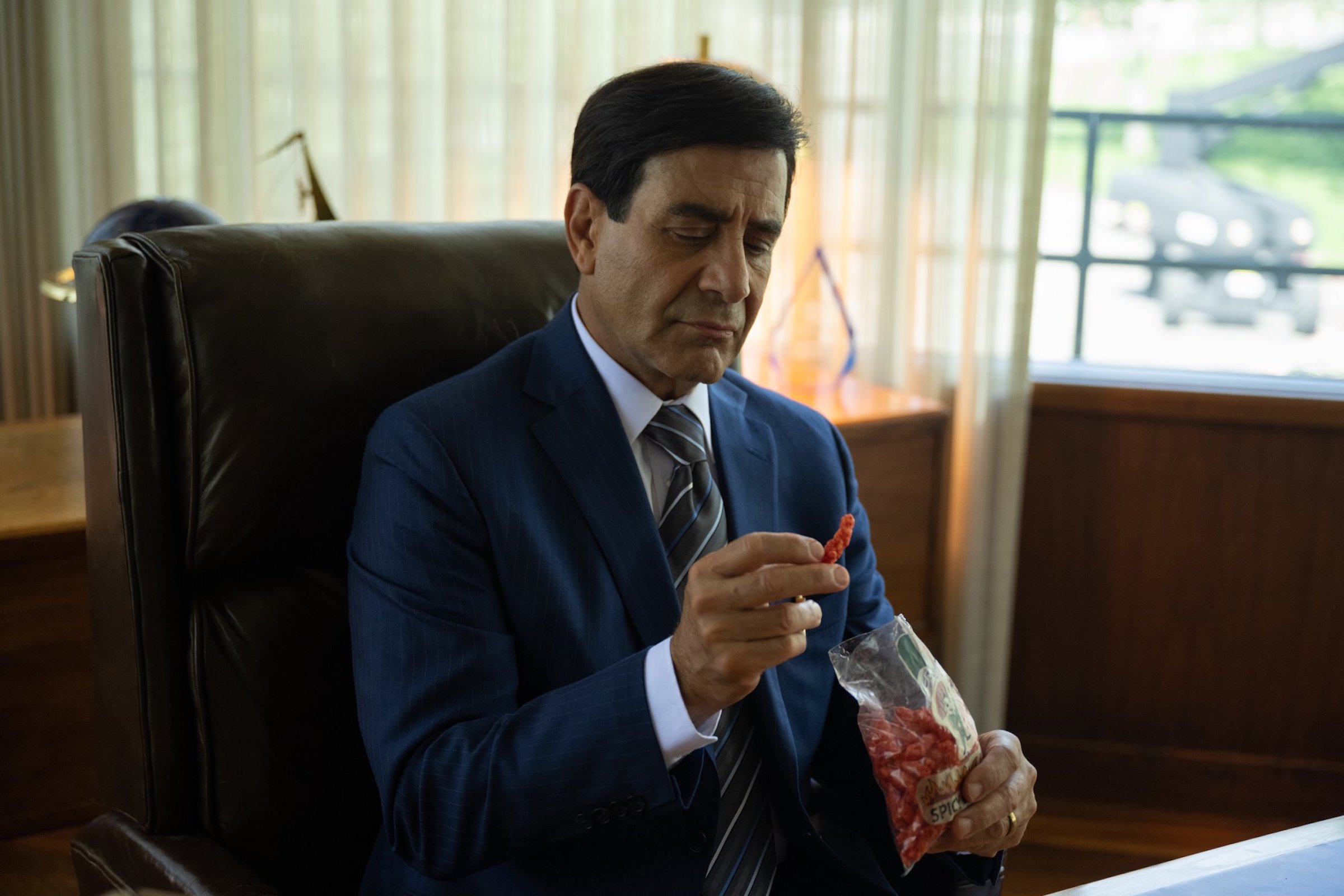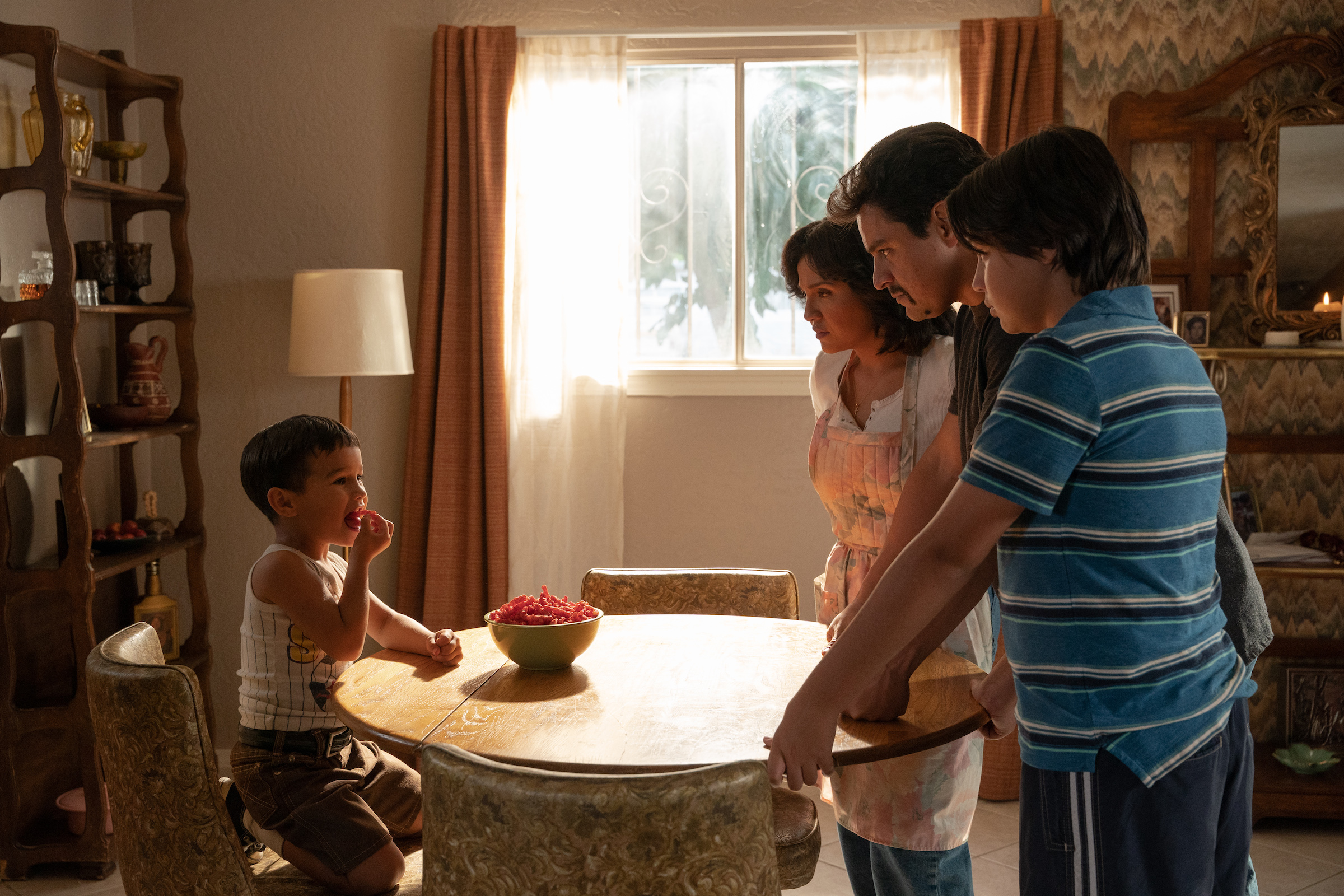Flamin’ Hot, Eva Longoria’s feature directorial debut, is not a factual history of the Flamin’ Hot Cheeto—nor is it meant to be.
Instead, in diving into the story of Richard Montañez—the man who claims to have invented the cult favorite spicy snack—Flamin’ Hot tells an acutely human story of a man trying to break generational cycles and start life anew.
Releasing June 9 on both Hulu and Disney+ (becoming the first new movie to do so), Flamin’ Hot is based on Montañez’s first memoir, A Boy, a Burrito, and a Cookie: From Janitor to Executive. Jesse Garcia plays Montañez, unemployed and selling drugs before he was hired at Frito-Lay.
In Montañez’s telling, he invented a chile slurry with his family that would become the spice base for the eventual Flamin’ Hot Cheeto. Frito-Lay has denied these claims, according to the Los Angeles Times, citing interviews with former employees and the company’s archival record. But Flamin’ Hot worries less about these details and concentrates on the significance of Montañez’s story: While working for a company that largely kept Latinos out of the C-suite, he broke through with tenacity, tailoring the flavor to his community. In both the movie and real life, he climbed the chain of command, eventually becoming the vice president of multicultural sales and community promotions for PepsiCo.
Flamin’ Hot is, however, authentic when it comes to what its director, Longoria, has said matters most: cultural specificity. Linda Yvette Chávez, the co-writer of the film, thoroughly revised a draft of a script written by Lewis Colick into Longoria’s vision, massaging in the Chicano culture of Southern California in the ‘70s, ‘80s, and ‘90s.
How Flamin’ Hot nails cholo and Chicano culture
Montañez never graduated high school—he was not fluent in the corporate jargon of the Frito-Lay executive suite. In the movie, he translates what he imagines Roger Enrico, CEO of parent company PepsiCo, and the other bigwigs might be saying about an economic downturn into a language he does understand: cholo.
“The corporate suite at Frito-Lay felt like gangsters throwing down in a drug den,” Montañez narrates. “‘Cause let’s be real, that’s pretty much what C-suiters are: gangsters with money. Enrico was pissed.”
“He was like, ‘You pendejos are out here tellin’ me these little punks like Nabisco and Eagle Snacks are getting more feria than us?” Montañez continues, pretending to be Enrico. “Biting off our territory, and youse estúpidos OK with that?’”
“And this gabacho was all, ‘Nah, big homie,’” Montañez says, as another executive. “We still got the good stuff. Cheetos, Fritos, Doritos. People still dishin’ out lana for the classics, bro.’”
“What?” Montañez interjects, as himself again. “You need a cholo translator? All right, I got you.”
“‘So sales are down?’ ‘Yeah.’ ‘Unfortunately.’ ‘Yeah, that’s what it looks like right now.’”

Montañez would have been fluent in the language of gangs and hustling, Chávez tells TIME. “These guys are hustlers, just like him,” she says. From Richard’s perspective, “this is probably how it went down in the room, and they probably threw down about everything. And letting them each be a different type of character from that cholo culture and world.”
Montañez and his wife, Judy (played by Annie Gonzalez), were cholos: young Mexican Americans who belonged to an urban gang subculture. (Colloquially and on the street, chola and cholo culture is known for its trademark aesthetic: pencil-thin eyebrows, lips with a dark and defined liner, cruising lowriders, stylized tattoos.) But then Montañez got a job at Frito-Lay’s plant in Rancho Cucamonga, Calif. and things started looking up.
“I grew up with cholitos in my family,” Chávez says. “I see them in three dimensional ways, and so does Eva. When you create from a place of love, you’re gonna get a nuanced representation of that. So that’s where I write from in everything that I do, allowing us to be flawed and complex and also beautiful.”
Chávez, perhaps best known for co-creating the series Gentefied, about three cousins fighting to keep their grandfather’s Boyle Heights taco shop in business, is the daughter of two immigrants from Mexico, and grew up in Norwalk, Calif., a deeply Latino city in Los Angeles County. Longoria, for her part, was born in Corpus Christi, Texas to two Mexican parents. Montañez was born into a Mexican American family near San Bernardino and was raised in and around a migrant labor camp outside of Los Angeles.
When Chávez joined the project, she met first with Montañez, at his house in the Inland Empire, a region next to Southern California. His whole family was there, kids and grandkids, and they’d jump in to fill in any gaps in the story. Richard felt like her dad, she says: a working-class man who worked in factories and dealt with racism. Judy felt like her mom, her prima, “the women in my community who are always holding it down.”
She felt “a sense of relief from them, to sit down with a Latina director and a Latina writer and say, ‘OK, we can turn off the code-switching, and we can be us, and we can tell you truly what we went through,’” Chávez says. “‘Because just looking at you, I know that you know my experience.’ They’re right. I do.”

How Flamin’ Hot handles the muddled story of the spicy Cheeto
While Flamin’ Hot has been well-received (it won the headliner audience award at South by Southwest in March), the details of Montañez’s story have raised eyebrows. In two memoirs—A Boy, a Burrito, and a Cookie and Flamin’ Hot: The Incredible True Story of One Man’s Rise from Janitor to Top Executive—and countless speeches, Montañez has said that he invented Flamin’ Hot Cheetos.
But in May 2021, while the film was in development, the Los Angeles Times published an investigation in which Frito-Lay denied that he invented the snack. According to the Times, a separate team within Frito-Lay came up with the creation. “We value Richard’s many contributions to our company, especially his insights into Hispanic consumers, but we do not credit the creation of Flamin’ Hot Cheetos or any Flamin’ Hot products to him,” the company said in a statement. He did, however, work on Sabrositas, a line of products pitched at the Latino market in the Los Angeles area.
Less than a week later, PepsiCo, Frito-Lay’s parent company, backtracked. “The information we shared with the media has been misconstrued by some,” the company said in a statement. “We attribute the launch and success of Flamin’ Hot Cheetos and other products to several people who worked at PepsiCo, including Richard Montañez.”
Longoria and Chávez agree: They didn’t set out to tell the history of the Flamin’ Hot Cheeto. The film does, however, acknowledge a group in the Midwest that was designing a spicy snack to be sold in inner-city mini-marts at the same time, which aligns with the official record.
“So much of his story, especially when you watch the film, is how do you get people to value your worth, give you your worth and your credit?” Chávez says. “And for BIPOC people, it’s been a journey for all of us. Sometimes history is skewed. And sometimes those people in positions of power have the privilege to skew that history.”
More Must-Reads from TIME
- Donald Trump Is TIME's 2024 Person of the Year
- Why We Chose Trump as Person of the Year
- Is Intermittent Fasting Good or Bad for You?
- The 100 Must-Read Books of 2024
- The 20 Best Christmas TV Episodes
- Column: If Optimism Feels Ridiculous Now, Try Hope
- The Future of Climate Action Is Trade Policy
- Merle Bombardieri Is Helping People Make the Baby Decision
Contact us at letters@time.com